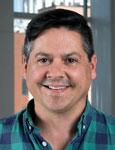It was a tornado that forged an almost twenty-year collaboration between Appleton-area artist Judith Waller and scientist James Brey. In 1993 Waller was a new Professor of Art at UW–Fox Valley with a burgeoning interest in environmental issues. Brey was a faculty colleague in the department of Geography and Geology.
After a few discussions, it became clear that Brey and Waller shared an interest in the ways in which science and art connect, an interest that bled into their similar style of instruction. Brey, for instance, would ask students to draw diagrams and other representations of the physical properties of materials his classes were exploring. He appreciated the close observation required to do a detailed drawing and the challenge of capturing the shape, size, and relationship of object components and their relationship to the whole. Waller, on the other hand, was always on the lookout for patterns in both plant and mineral structures, from which she felt students could learn much about the natural world as well as art. Each began to bring students into the other’s lab.
Outside of class, Brey and Waller began to “tutor” each other in art and earth sciences, all the while considering how a painting might tell an environmental story and how a carefully constructed bit of scientific prose could add to the mix. Waller began to create work from essays and ideas provided by Brey, and Brey would go to her studio to learn about artistic composition while discussing ways to make a painting or image more directly respond to a scientific finding or theory.
Then came the tornado. Not an actual tornado, but a large-scale model in Brey’s lab made of dry ice, hot plates with steaming pots of water, and lots of fans (on the floors, on tables, even suspended from the ceiling). Tiny houses from a Monopoly game were used for scale, as the seven foot tornado whirled with a palpable force.

“Jim really had to really control the environment to make the perfect twister,” says Waller. “I would bring my drawing students into the mix and have them make drawings of the tornado. This was tricky since the thing was like a living organism; it moved, rose, fell, dissipated and would suddenly resurrect! It was a wonderful opportunity for the students to learn gestural drawing techniques and master the art of suggestion rather than focusing on the details required in a rendered drawing.”
Brey and Waller noticed that the tornado had a curious effect on bystanders who were simultaneously excited and agitated but pleasantly calm. They realized how very visceral this experience was, and began to form an idea for a broader public art installation that could capture this power and create awareness of—and stimulate action around—important scientific issues.
Over the next few years the two worked on Layers: Places in Peril, a series of large-scale paintings that explore how the fragile built environments in which we live can be dramatically altered by changes in the global climate. The two professors created an exhibition from the Layers project, which opened in 2012 at the Aylward Gallery at UW–Fox Valley and was also displayed at the Indiana University of Pennsylvania Museum in the fall of 2013. Of this groundbreaking series, Brey says that, “by looking scientifically at our layered world and depicting it in layered paintings, scientists and artists bring together academic elements that individually are interesting, but which together scream out for attention and understanding.”
Continuing their exploration of the intersections of science and art, the two began work on another series titled small problems, BIG TROUBLE, with an new exhibition of works set to open this spring at the Aylward Gallery. An extended collaboration with other scientists, small problems, BIG TROUBLE was developed to create awareness of subjects that are small in scale (e.g. soil, parasites, dust, viruses, micro pollutants, invasive species) yet can pose significant threats to human life.
Each painting in the small problems, BIG TROUBLE series is oil and mixed media—which includes a reflective material such as gold or other metal leafing—on an 18-by-18-inch canvas. According to Waller, each painting provides a glimpse of a small problem linked in a chain of causality to “big trouble” for humans. Many of the subjects have connections to or are emblematic of the changing climate. For instance, the image “Dust” reflects core samples dug from ocean floors in order to track historic climatic shifts and was composed in collaboration with geoscientist Steven Hoven from Indiana University of Pennsylvania. Working with UW–Fox Valley associate professor of Biological Sciences Teresa Weglarz, Waller produced “Blue Green Algae,” which invokes a common summertime threat to aquatic life.

“I incorporate some element that pertains to the idea of ‘reflection’—sometimes literal as in a mirror surface, or sometimes something more oblique like a shadow,” says Waller, noting how the “reflective elements point to the fact that these issues are [ones] we face today, and [our response to them] reflects back on us.
As in previous collaborations, Brey and Waller’s plans include an educational component: at UW–Fox Valley and at Appleton Area School District high schools, students will exhibit both an art piece and scientific text panel focusing on environmental issues. Brey and Waller hope students will use this opportunity to develop their own cross-disciplinary approaches to art and science and will also work to increase awareness of environmental issues.
Brey, who is currently director of the American Meteorological Society’s Education Program in Washington DC, says that while he reaches thousands of people through course work, text books, and other vehicles, his work with Waller is in some ways the most rewarding.
“Our collaborative projects reach a totally different audience: people wandering into a gallery and confronting some of these things for the first time,” he says. “I mean, wow! You get this visceral response to this learning, this informative strike. That’s the magic of our collaboration.”




